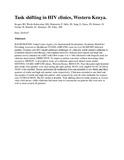Task shifting in HIV clinics, Western Kenya.

View/
Date
2010-07Author
Kosgei, RJ
Wools-Kaloustian, KK
Braitstein, P
Sidle, JE
Sang, E
Gitau, JN
Sitienei, JJ
Owino R.
Mamlin, JJ.
Kimaiyo, SN
Siika, AM
Type
ArticleLanguage
enMetadata
Show full item recordAbstract
BACKGROUND:
United states Agency for International development-Academic Model for Providing Accesses to Healthcare (USAID-AMPATH) cares for over 80,000 HIV-infected patients. Express care (EC) model addresses challenges of: clinically stable patient's adherent to combined-antiretroviral-therapy with minimal need for clinician intervention and high risk patients newly initiated on cART with CD4 counts < or = 100 cells/mm3 with frequent need for clinician intervention.
OBJECTIVE:
To improve patient outcomes without increasing clinic resources.
DESIGN:
A descriptive study of a clinician supervised shared nurse model.
SETTING:
USAID-AMPATH clinics, Western Kenya.
RESULTS:
Four thousand eight hundred and twenty four patients were seen during the pilot period, 90.4% were eligible for EC of whom 34.6% were enrolled. Nurses performed all traditional roles and attended to two thirds and three quarters of stable and high risk patient visits respectively. Clinicians attended to one third and one quarter of stable and high risk patient visits respectively and all visits ineligible for express care.
CONCLUSION:
The EC model is feasible. Task shifting allowed stable patients to receive visits with nurses, while clinicians had more time to concentrate on patients that were new as well as more acutely ill patients.
URI
http://www.ncbi.nlm.nih.gov/pubmed/23451549http://erepository.uonbi.ac.ke:8080/xmlui/handle/123456789/57864
Citation
East Afr Med J. 2010 Jul;87(7):299-303Publisher
University of Nairobi, Department of Clinical Medicine and Therapeutics
Collections
- Faculty of Health Sciences (FHS) [10378]
